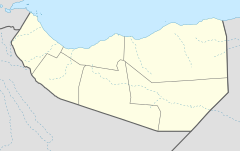Masjid al-Qiblatayn, Zeila: Difference between revisions
R Prazeres (talk | contribs) |
Added clear sources of an Islamic foothold at Zeila 7th century Tags: Reverted Visual edit Mobile edit Mobile web edit |
||
| Line 24: | Line 24: | ||
==Description and history== |
==Description and history== |
||
The mosque was built in the 7th century [[Common Era|CE]] shortly after the [[migration to Abyssinia|hijrah]], the migration of the early followers of [[Muhammad]] to [[Ethiopia|Abyssinia]].<ref name="Btgpb">{{cite book |last= |
The mosque was built in the 7th century [[Common Era|CE]] shortly after the [[migration to Abyssinia|hijrah]], the migration of the early followers of [[Muhammad]] to [[Ethiopia|Abyssinia]].<ref name="Btgpb">{{cite book |last=Central Intelligence |first=Agency (gov) |url=https://www.cia.gov/readingroom/docs/CIA-RDP80-01444R000100060001-2.pdf |title=INTELLIGENCE HANDBOOK FOR SPECIAL OPERATIONS SOMALI REPUBLIC |date=July 1966 |publisher=Central Intelligence Agency (gov) |year=2007 |isbn= |page=Page 4 |pages=-5 |language=English}}</ref> According to locals it is the oldest mosque in the city.<ref name=":0" /> The mosque's name means 'mosque of the two [[qibla]]hs', referring to its two [[mihrab]]s. According to tradition, one of the mihrabs was oriented north toward [[Mecca]] and the other northwest toward [[Jerusalem]].<ref name=":0">{{Cite book |last=Fauvelle-Aymar |first=François-Xavier |url=https://books.openedition.org/cfee/698 |title=Espaces musulmans de la Corne de l’Afrique au Moyen Âge. |last2=Hirsch |first2=Bertrand |last3=Bernard |first3=Régis |last4=Champagne |first4=Frédéric |publisher=Centre français des études éthiopiennes |year=2011 |isbn=9782821882652 |editor-last=Fauvelle-Aymar |editor-first=François-Xavier |location=Addis Ababa |pages=27-74 |language=fr |chapter=Le port de Zeyla et son arrière-pays au Moyen Âge: Investigations archéologiques et retour aux sources écrites |editor-last2=Hirsch |editor-first2=Bertrand |chapter-url=https://books.openedition.org/cfee/714}}</ref> |
||
As of 2011, the building is largely in ruins and only one mihrab, oriented northward, was visible. The remains of another structure nearby are visible, possibly indicating that the mosque underwent two different phases of construction. It also contains the tomb of a [[sheikh]] named Babu Dena.<ref name=":0" /> |
As of 2011, the building is largely in ruins and only one mihrab, oriented northward, was visible. The remains of another structure nearby are visible, possibly indicating that the mosque underwent two different phases of construction. It also contains the tomb of a [[sheikh]] named Babu Dena.<ref name=":0" /> |
||
Revision as of 13:05, 6 January 2024
| Masjid al-Qiblatayn (Arabic: مَـسْـجِـد الْـقِـبْـلَـتَـيْـن) "Masjidka labada qibla" "Mosque of the two Qiblahs" | |
|---|---|
 | |
| Religion | |
| Affiliation | Islam |
| Region | Horn of Africa |
| Location | |
| Location | Zeila, Awdal, Somaliland. |
| Geographic coordinates | 11°21′14″N 43°28′26″E / 11.35389°N 43.47389°E |
| Architecture | |
| Type | mosque |
| Completed | 7th century |
| Minaret(s) | 1 |
Masjid al-Qiblatayn (Somali: masjidka labada qibla, lit. 'Mosque of the two Qiblas'; Arabic: مَـسْـجِـد الْـقِـبْـلَـتَـيْـن) is a mosque in Zeila,[1][2] situated in the western Awdal region of Somaliland
Description and history
The mosque was built in the 7th century CE shortly after the hijrah, the migration of the early followers of Muhammad to Abyssinia.[3] According to locals it is the oldest mosque in the city.[4] The mosque's name means 'mosque of the two qiblahs', referring to its two mihrabs. According to tradition, one of the mihrabs was oriented north toward Mecca and the other northwest toward Jerusalem.[4]
As of 2011, the building is largely in ruins and only one mihrab, oriented northward, was visible. The remains of another structure nearby are visible, possibly indicating that the mosque underwent two different phases of construction. It also contains the tomb of a sheikh named Babu Dena.[4]
Influence of the companions
The construction of this mosque is tied to the history of Islam in Somalia. The mosque is known as the site of where early companions (sahaba) of Muhammad established a mosque shortly after the first migration to Abyssinia.[5]
See also
- Lists of mosques
- List of mosques in Africa
- List of mosques in Egypt
- Arba'a Rukun Mosque
- Fakr ad-Din Mosque
- Islam in Africa
- Mosque of Islamic Solidarity
- Dir (clan)
References
- ^ "Liste des premières mosquées au monde prophètique, rashidun et omeyyade selon les écris historique et les traces archéologiques". Histoire Islamique (in French). 2014-06-15. Retrieved 2017-09-24.
- ^ http://markanews.net/2017/03/masjid-qibla-tayn-saylac-kuma-yaalo-ee-waa-madiina-tariikhda-ha-la-saxo-wq-khadar-aar/ [dead link]
- ^ Central Intelligence, Agency (gov) (July 1966). INTELLIGENCE HANDBOOK FOR SPECIAL OPERATIONS SOMALI REPUBLIC (PDF). Central Intelligence Agency (gov). p. Page 4.
{{cite book}}: Check date values in:|year=/|date=mismatch (help); More than one of|pages=and|page=specified (help) - ^ a b c Fauvelle-Aymar, François-Xavier; Hirsch, Bertrand; Bernard, Régis; Champagne, Frédéric (2011). "Le port de Zeyla et son arrière-pays au Moyen Âge: Investigations archéologiques et retour aux sources écrites". In Fauvelle-Aymar, François-Xavier; Hirsch, Bertrand (eds.). Espaces musulmans de la Corne de l’Afrique au Moyen Âge (in French). Addis Ababa: Centre français des études éthiopiennes. pp. 27–74. ISBN 9782821882652.
- ^ Briggs, Phillip (2012). Somalia. Bradt Travel Guides. p. 7. ISBN 978-1841623719.
Further reading

